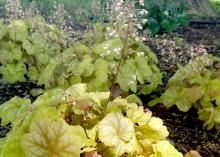Information Possibly Outdated
The information presented on this page was originally released on May 28, 2018. It may not be outdated, but please search our site for more current information. If you plan to quote or reference this information in a publication, please check with the Extension specialist or author before proceeding.
Heuchera varieties thrive in landscapes
One landscape plant I wish I grew more of is coral bells, known botanically as Heucheras.
I absolutely love the colorful foliage with a seemingly unlimited variety of textures that add interest in any garden or landscape. Some have ruffled margins, some have deep cuts, and others feature smooth margins. Texture is certainly on display with coral bells.
The first coral bells had green foliage. It’s amazing how imaginative and productive the breeders have been. Lately it seems like the green foliage selections are hard to find, particularly in the Deep South because of our hot and humid summer season.
New selections have purple, red and white marbling as well as different colored veins. Foliage colors of bright gold, orange and brown abound -- and others with different colors on top and bottom add flashes of color when the wind blows. These more colorful selections seem to do better in my landscape.
Most coral bells will be 1 to 3 feet tall and up to 2 feet wide. There are smaller, more compact selections available. Coral bells can have some of the darkest foliage around, ranging from deep burgundy to black.
I was recently visiting the Mississippi State Trial Gardens in Starkville, where they are creating quite a display of coral bells. Here are some of my new favorites.
I love the silky, dark foliage of Black Taffeta. When grown in full shade, the large glossy leaves will become almost black. These plants were showing good vigor planted in the light shade of an oak.
I thought Champagne was stunning. This medium-sized plant displays foliage with peach, gold and chartreuse tones. I love the maroon flower stalks with bright, light-peachy flower clusters.
Creole Nights is a great plant for the landscape. Dark, almost-black leaves are produced in a dense mounding habit. The foliage is much larger than some of the other blackish coral bells.
Spellbound features shimmering silver-toned leaves with tints of rose and purple. This is a great plant that forms a dense mound and makes a great combination container plant.
Coral bells don’t have many pests. Perhaps the biggest problem is leaf scorching, especially if they are not planted in partial shade.
Coral bells are not hard to grow if you follow a few tips for maintaining healthy clumps. For our Mississippi gardens and landscapes, shade is a must. Find a spot with a few hours of afternoon shade for the coral bells in your landscape. Selections with showy flowers will benefit from more sun exposure and have stronger flowering stems.
Well-drained soil with a lot of compost mixed in is a must. Plant the crown a little higher than the surrounding grade. This will increase drainage and help prevent the crown from rotting. The addition of compost or a general garden fertilizer once in the spring will meet nutritional needs.
Provide coral bells with 2 to 3 inches of mulch to help keep the soil cool. In either spring or fall, carefully dig the plant and break the pieces up where you see the small leaves coming out. Dip these pieces in rooting hormone and push them into the soil in new areas of the garden.
Coral bells are evergreen, and the winter months in Mississippi can leave the foliage looking ratty. In the spring, prune away the old foliage, being careful not to damage the crown. The new growth will come in strong. Later in the summer, removing the spent flower stems will keep your coral bells looking neat and trim.




